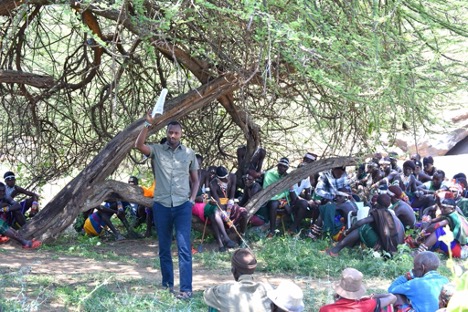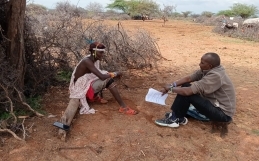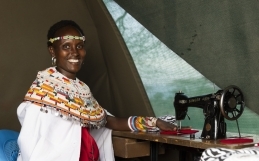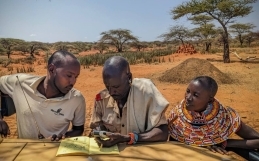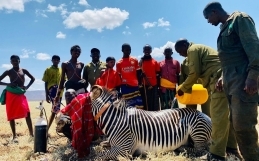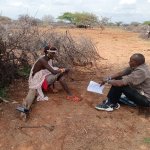By Andy Lekisanyal, GZT Rangelands Manager
Holistic Land and Livestock Management (HLLM) is an innovative tool designed to enhance rangeland health through regenerative grazing practices. This method harmonizes the needs of people, livestock, and wildlife by integrating economic, social, and environmental elements. It promotes strategic grazing where community herds are bunched together, utilizing the trampling action of cattle to stimulate grass growth and improve degraded areas. Grazing plans are developed collaboratively, ensuring that traditional practices are respected and utilized while also integrating new approaches.
One of the key factors contributing to the success of HLLM has been the system of incentives GZT and the conservancies offer to participating communities. Herders receive salaries for their work, boma (livestock enclosure) fencers are compensated for their labour, and veterinary services and rations are provided to ensure the well-being of the livestock and their caretakers. Additionally, boma fencers help control the spread of indigenous encroacher tree species by using branches from these trees to create temporary bomas. The bomas, which are rotated regularly, are placed on bare ground to revitalize the soil using livestock hooves to break up capped soil and the nutrients from livestock dung and urine to improve soil health. The importance of these rotations has been highlighted through community training, with the people of Nkiseu village leading the way in constructing double the number of required bomas voluntarily. This proactive response from the community has resulted in increased restoration of degraded land.
HLLM Recent Successes
One of the most notable achievements this year has been the successful implementation of restorative grazing practices in eight villages, with community conservancies enthusiastically embracing the concept. For example, in Kalama, cattle were reintroduced six years after the last bunching took place. Even more significantly, the conservancies have begun applying these regenerative grazing principles independently, without direct oversight from GZT. This autonomy represents a major win for the rangelands team, as it shows that the capacity-building efforts are paying off, with communities taking ownership of their rangeland management.
The number of Grassland Champions has also grown this year. There are now 12 champions, who play a key role in both restoration efforts and spreading knowledge about regenerative grazing practices. This has not only led to the restoration of more land but also resulted in an increase in grass harvesting and planting, vital for the health of the rangelands. Additionally, more villages have joined the program, showing a growing commitment to expanding the HLLM approach beyond the initial pilot areas. Importantly, Grevy’s zebra have been frequently sighted in the restored lands and grazing blocks, demonstrating that the program is achieving its dual goals of improving land health and conserving Grevy’s zebra.
Community-Led Contributions to HLLM
A significant indicator of the community’s commitment to HLLM is the voluntary labour and resources that have been contributed to complement the incentives provided by GZT. In Nkiseu village, community members have taken it upon themselves to build additional bomas, recognizing the role that these structures play in preventing land degradation and fostering regeneration. Despite the financial challenges that come with rotating bomas weekly, as prescribed by HLLM, communities have stepped in to bridge the gap by constructing these vital structures more frequently. Also, the community has embarked on their traditional ways of fetching water to complement GZT’s truck supply by using their donkeys to transport water.
In addition, cultural shifts have been observed. Traditionally, in Samburu society, boma construction is a responsibility reserved for men. However, in some areas, such as Nkiseu, women have been actively involved in building bomas, showcasing the community’s adaptability and their desire to involve all members in the success of the grazing plans. Through established village level structures like village-based committees (VBC) and moran (warrior) councils, all social groups, especially youths/morans and women, have been empowered and their contribution to rangelands work has been significant. This inclusive approach not only strengthens the community’s social fabric but also enhances the effectiveness of the rangeland management strategies.
Expanding the Reach and Impact of HLLM
The lessons learned in GZT’s partner conservancies have started to resonate beyond the initial three areas. GZT has been invited to provide training on regenerative grazing at Oldonyiro Nanapa Conservancy, where the positive response from the community further validated the impact of the HLLM tool. Elders frequently express their appreciation for the dedication of GZT’s rangelands team, noting their commitment to ensuring that everyone fully understands and applies the grazing plans.
The challenges ahead, however, are not insignificant. GZT’s goal is to have 18 out of the 36 villages in its partner conservancies fully implementing HLLM principles by 2027. Achieving this will require patience, resources, and sustained community engagement. The growing demand for incentives, as more villages buy into the grazing plans, will place increasing pressure on GZT to mobilize resources. As the program expands, there will also be a need to increase manpower to manage the workload effectively.
Future Prospects
Looking ahead, GZT envisions growing partnerships with stakeholders, including county and national governments, to scale up HLLM across larger landscapes. With additional resources and collaboration, the potential for widespread rangeland restoration is immense. Grevy’s zebra conservation remains at the core of this work, and the team is optimistic about the future. Already, Grevy’s zebra are doing well in areas where HLLM has been implemented, and GZT is committed to ensuring that this continues. By working together, communities, conservancies, and conservationists can build a future where both rangelands and Grevy’s zebra flourish.
The work of Grevy’s Zebra Trust is about building resilience against climate change, fostering community empowerment, and ensuring the long-term survival of one of Africa’s most iconic species. And as the success stories from the field demonstrate, this is a mission that we are fully committed to.

